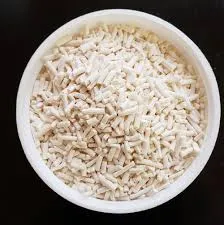
propargyl alcohol
Propargyl Alcohol A Versatile Compound in Organic Chemistry
Propargyl alcohol, also known as 3-butyn-1-ol, is an organic compound with the molecular formula C₃H₄O. It is characterized by a triple bond between the first and second carbon atoms, along with a hydroxyl group (-OH) attached to the terminal carbon. This unique structure endows propargyl alcohol with a range of significant chemical properties and applications, making it a valuable compound in organic chemistry and various industrial processes.
Chemical Properties and Structure
Propargyl alcohol is a colorless to pale yellow liquid with a characteristic odor. It has a boiling point of approximately 97 °C and is soluble in water and many organic solvents. The presence of both the alkyne and alcohol functional groups makes it an interesting subject for chemical reactions. The triple bond allows for reactions typical of alkynes, such as nucleophilic additions and cycloadditions, while the hydroxyl group can participate in reactions characteristic of alcohols, such as dehydration and oxidation.
Synthesis of Propargyl Alcohol
Propargyl alcohol can be synthesized through various methods. One common synthetic route is the hydration of propyne, a simple alkyne, using water in the presence of a catalyst. Alternatively, it can be prepared through the reaction of an alkyne with formaldehyde followed by reduction. The availability of multiple synthetic pathways makes propargyl alcohol accessible for laboratory synthesis and industrial applications.
Applications in Organic Synthesis
One of the primary uses of propargyl alcohol is as an intermediate in organic synthesis. It serves as a building block for the preparation of more complex molecules, including pharmaceuticals and agrochemicals. For example, propargyl alcohol can be transformed into propargyl ethers, which are valuable in the creation of natural products and complex organic compounds.
propargyl alcohol

Additionally, propargyl alcohol has been utilized in the synthesis of various polymer materials. Its unique functional groups allow for reactions that can lead to the formation of cross-linked networks, making it useful in the development of adhesives and coatings with desirable mechanical properties.
Anticancer Potential
Recent research has indicated that propargyl alcohol may possess anticancer properties. Studies have shown that propargyl alcohol can induce apoptosis, or programmed cell death, in certain cancer cell lines. This effect is thought to be mediated through the modulation of specific cellular pathways involved in cell survival and proliferation. As such, propargyl alcohol could be further explored as a potential candidate for anticancer therapies, meriting additional investigation in clinical settings.
Health and Safety Considerations
While propargyl alcohol exhibits significant potential in various applications, it is essential to be aware of its safety profile. The compound may cause irritation to the skin, eyes, and respiratory tract. Therefore, proper safety precautions should be taken when handling propargyl alcohol in both laboratory and industrial environments. Protective equipment, such as gloves and goggles, should be utilized to minimize the risk of exposure.
Conclusion
In summary, propargyl alcohol is a versatile and essential compound in the field of organic chemistry. Its unique structure and functional groups offer a broad range of reactivity that is harnessed in the synthesis of various complex molecules and materials. As research continues to unfold, propargyl alcohol's role in medicinal chemistry, particularly in the development of anticancer agents, presents exciting opportunities for future exploration. Given its significance in multiple sectors, understanding propargyl alcohol’s chemical properties and applications will be vital for chemists and industry professionals alike. With careful consideration of safety and efficacy, propargyl alcohol could pave the way for new advancements in both industrial applications and therapeutic developments.
-
Buy High-Quality Trichloroisocyanuric Acid for Sale | TCCA 90% SupplierNewsAug.30,2025
-
Pure Sodium Dichloroisocyanurate Dihydrate | Powerful DisinfectantNewsAug.29,2025
-
Industrial Chemicals: Quality & Purity for Every IndustryNewsAug.28,2025
-
Nitrile Rubber Honoring Strict Production StandardsNewsAug.22,2025
-
Aspartame Ingredients Honoring Food Safety ValuesNewsAug.22,2025
-
Fertilizer for Balanced Plant NutritionNewsAug.22,2025
-
Cyanide Gold Processing with High Purity AdditivesNewsAug.22,2025
Hebei Tenger Chemical Technology Co., Ltd. focuses on the chemical industry and is committed to the export service of chemical raw materials.
-

view more DiethanolisopropanolamineIn the ever-growing field of chemical solutions, diethanolisopropanolamine (DEIPA) stands out as a versatile and important compound. Due to its unique chemical structure and properties, DEIPA is of interest to various industries including construction, personal care, and agriculture. -

view more TriisopropanolamineTriisopropanolamine (TIPA) alkanol amine substance, is a kind of alcohol amine compound with amino and alcohol hydroxyl, and because of its molecules contains both amino and hydroxyl. -

view more Tetramethyl Thiuram DisulfideTetramethyl thiuram disulfide, also known as TMTD, is a white to light-yellow powder with a distinct sulfur-like odor. It is soluble in organic solvents such as benzene, acetone, and ethyl acetate, making it highly versatile for use in different formulations. TMTD is known for its excellent vulcanization acceleration properties, which makes it a key ingredient in the production of rubber products. Additionally, it acts as an effective fungicide and bactericide, making it valuable in agricultural applications. Its high purity and stability ensure consistent performance, making it a preferred choice for manufacturers across various industries.





